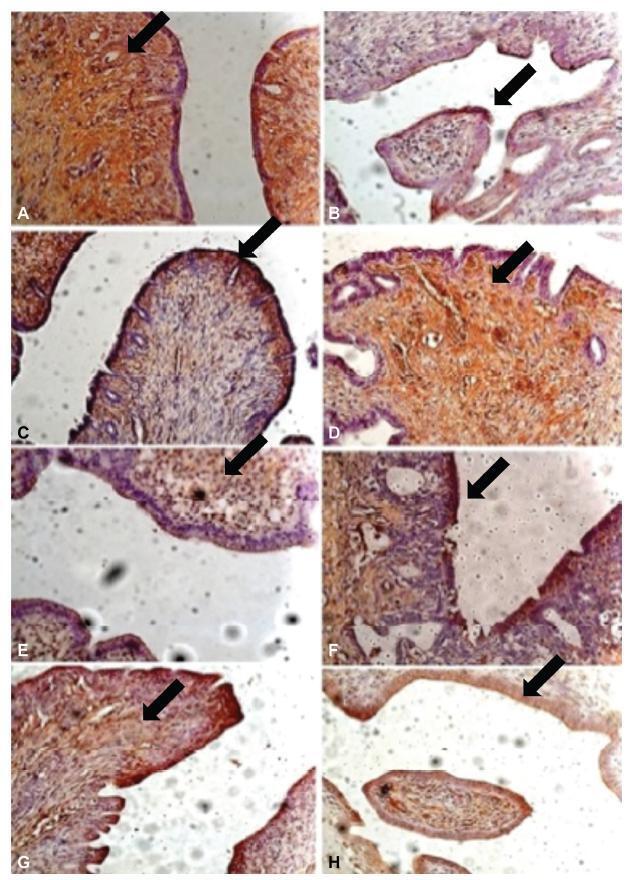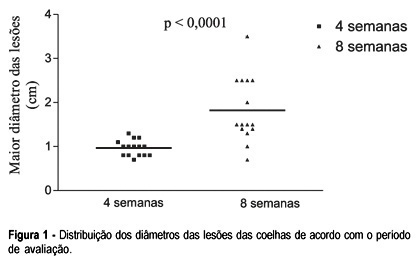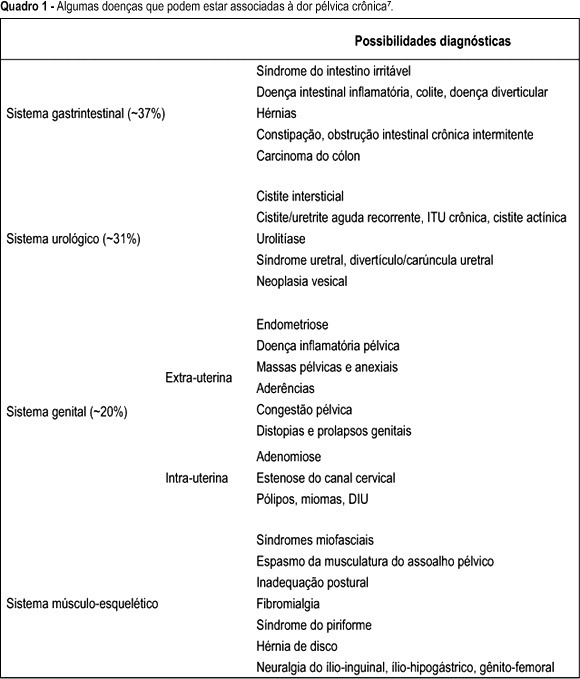You searched for:"Antonio Alberto Nogueira"
We found (31) results for your search.Summary
Rev Bras Ginecol Obstet. 2018;40(11):705-712
To characterize the patterns of cell differentiation, proliferation, and tissue invasion in eutopic and ectopic endometrium of rabbits with induced endometriotic lesions via a well- known experimental model, 4 and 8 weeks after the endometrial implantation procedure.
Twenty-nine female New Zealand rabbits underwent laparotomy for endometriosis induction through the resection of one uterine horn, isolation of the endometrium, and fixation of tissue segment to the pelvic peritoneum. Two groups of animals (one with 14 animals, and the other with15) were sacrificed 4 and 8 weeks after endometriosis induction. The lesion was excised along with the opposite uterine horn for endometrial gland and stroma determination. Immunohistochemical reactions were performed in eutopic and ectopic endometrial tissues for analysis of the following markers: metalloprotease (MMP-9) and tissue inhibitor of metalloprotease (TIMP-2), which are involved in the invasive capacity of the endometrial tissue; and metallothionein (MT) and p63, which are involved in cell differentiation and proliferation.
The intensity of the immunostaining for MMP9, TIMP-2, MT, and p63 was higher in ectopic endometria than in eutopic endometria. However, when the ectopic lesions were compared at 4 and 8 weeks, no significant difference was observed, with the exception of the marker p63, which was more evident after 8 weeks of evolution of the ectopic endometrial tissue.
Ectopic endometrial lesions seem to express greater power for cell differentiation and tissue invasion, compared with eutopic endometria, demonstrating a potentially invasive, progressive, and heterogeneous presentation of endometriosis.

Summary
Rev Bras Ginecol Obstet. 2000;22(2):71-77
DOI 10.1590/S0100-72032000000200003
Purpose: to compare hospital costs between laparoscopically assisted vaginal hysterectomy (LAVH) and total abdominal hysterectomy (TAH), reporting the initial experience with the new approach in a communitary general hospital. Patients and Methods: eleven cases of LAVH and 23 of TAH, carried out from September 1998 to July 1999, were compared. Each patient's records and hospital charges were reviewed to collect the analyzed variables. Results: there was no statistical difference between the groups in relation to age, parity, and previous abdominal surgery. The main surgical indication for both groups was uterine leiomyomatosis. The LAVH group presented a shorter hospital stay with a median of one day, and the TAH group, of two days (p<0.01). LAVH showed to be 40.2% more expensive than TAH (p<0.01). Operating room charges contributed to the major part of hospital costs for both groups, corresponding to 79.8 and 57.9% of the total, for LAVH and TAH, respectively. LAVH infirmary charges were smaller than for TAH, with a statistically significant difference (p = 0.002). Conclusion: with shorter hospital stay and smaller infirmary costs, we demonstrated that LAVH provides better postoperative conditions and faster recovery than TAH. When done in a community general hospital, despite being more expensive, LAVH is an excellent option for uterine removal, and should be part of the therapeutical arsenal of gynecologic surgeons.

Summary
Rev Bras Ginecol Obstet. 2004;26(9):715-719
DOI 10.1590/S0100-72032004000900007
PURPOSE: development of a new experimental model of endometriosis induction in rabbits evaluating its temporal evolution both macro-and microscopically. METHODS: thirty female rabbits were submitted to endometriosis induction through the fixation of a piece of the left uterine horn to the abdominal peritoneum. After four or eight weeks the viability of the lesions was verified by laparoscopy. The lesions were observed endoscopically. The implants were measured and histological analyses were made. The groups were compared for the presence of endometriotic lesion on laparoscopy, presence of adhesions, implant size and histological aspects. For statistical analyses we utilized Student's t and Mann-Whitney's tests, with a statistical significance of 5%. RESULTS: endometriotic lesions were identified in all cases submitted to laparoscopy after 4 weeks of induction, 64% of them cystic, and in 80% of the rabbits after eight weeks, 66% of which cystic. The adhesions were present in 71% of the rabbits after 4 weeks (none in the implants) and in 80% of the rabbits after 8 weeks (13% in the implants). The lesions were significantly larger after 8 weeks (p<0,0001). The histological analyses showed 100% of endometrial tissue in both groups. CONCLUSION: this experimental model showed that it is possible to simulate endometriosis in rabbits with a viable and simple technique, also allowing to record the characteristics and development of the implants macro-and microscopically. Although the histological aspects were similar, the lesions after eight weeks were larger than after four, making their manipulation easier.

Summary
Rev Bras Ginecol Obstet. 2006;28(12):733-740
DOI 10.1590/S0100-72032006001200008
Chronic pelvic pain is a debilitating and highly prevalent disease with a major impact on quality of life and work productivity, beyond significant costs to health services. The dilemma of managing patients with chronic pelvic pain continues to frustrate physicians confronted with these complaints, in part because its pathophysiology is poorly understood. Consequently, its treatment is often unsatisfactory and limited to temporary symptom relief. In the present revision, we discuss the adequate management of chronic pelvic pain. We point out that a comprehensive medical history and physical examination should include special attention to gastrointestinal, urological, gynecological, muscle-skeletal, neurological, psychiatric, and endocrine systems. Thus, a multidisciplinary approach is recommended. Additionally, we emphasize that, although useful, specific surgical procedures, such as laparoscopy, should be indicated only to selected patients, mainly after excluding irritable bowel syndrome and pain of myofascial origin.

Summary
Rev Bras Ginecol Obstet. 2005;27(2):80-85
DOI 10.1590/S0100-72032005000200007
PURPOSE: to evaluate the evolution of pregnancy and the maternofetal prognosis in women with uterine leiomyomas. METHODS: a descriptive retrospective analysis of the medical records of 75 pregnant women with leiomyomas attended at the University Hospital, Faculty of Medicine of Ribeirão Preto, University of São Paulo, from January 1992 to January 2002. RESULTS: seventy-five pregnant women with leiomyomas were identified in a population of 34,467 pregnant women attended during this period (incidence of 0.2%). The diagnosis was made before pregnancy in 18 patients (24%), during the current pregnancy in 41 (54.6%), and during cesarean section in 16 (21.3%), of whom only six were not submitted to ultrasound scan during the prenatal period. Ten deliveries with preterm fetuses and five cases of premature rupture of the amniotic membranes were observed. Forty-seven patients (75.8%) were submitted to cesarean section, with the indication being directly related to the leiomyomas in 38.3% of them (anomalous presentation, obstruction of the birth canal, or uterine scar due to a previous myomectomy). Four cases of central necrosis, two cases of hyaline degeneration and one case of malignant potential of the leiomyoma were identified in patients submitted to postpartum myomectomy or hysterectomy. Sixty-one newborns (98.4%) had an Apgar score above 7 at the fifth minute of life, and surgery did not lead to a worse maternofetal prognosis when performed during pregnancy. CONCLUSIONS: the incidence of leiomyomas during pregnancy was 0.2% during the study period, with ultrasonography failing to diagnose 10 patients. Cesarean section was frequently indicated for this group of patients, but the presence of leiomyomas during pregnancy did not compromise the Apgar score of the newborns.
Summary
Rev Bras Ginecol Obstet. 2013;35(2):84-89
DOI 10.1590/S0100-72032013000200008
PURPOSES: To determine the prevalence of irritable bowel syndrome (IBS) in women with chronic pelvic pain (CPP) and its associated features; to determine whether IBS and CPP constitute the same syndrome. METHODS: Cross-sectional population survey with systematic sequential sampling according to census districts in which 1470 women were interviewed with respect to the sample calculation. The participants resided in their own homes, were at least 14 years of age, experienced menarche and presented CPP according to the American College of Obstetrics and Gynaecology. The dependent variable was IBS based on Rome III criteria in women with CPP, and the following independent variables were possibly associated with IBS: age, schooling, duration of pain, sedentary lifestyle, migraine, depression, insomnia, back pain, dysmenorrhea, dyspareunia, depression, history of violence, and intestinal symptoms. The sample was subdivided into groups with and without IBS. After the descriptive analysis of the variables was performed, the respective frequencies were evaluated using GraphPad Prism 5 software. To evaluate the association between the dependent variable and the independent variables, the χ² test was used with a significance level of 5%. RESULTS: The prevalence of IBS in women with CPP was 19,5%. Pain duration (p=0.03), back pain (p=0.002), history of physical or sexual abuse (p=0.002), and intestinal complaints were more prevalent in the group with IBS and CPP. There was no difference between the groups regarding other criteria. CONCLUSION: The data confirmed the literature, identified several aspects that were shared between the pathologies and supported the hypothesis that both pathologies can constitute the same syndrome.
Summary
Rev Bras Ginecol Obstet. 1999;21(2):85-90
DOI 10.1590/S0100-72031999000200005
Purpose: to present a profile of endometriosis, stages and results of treatment among the patients seen in our Service. Methods: the medical records of 155 patients with endometriosis treated during the period from 1991 to 1996 according to a preestablished protocol were examined. Results: mean patient age was 31 years, most patients were white, with regular menstrual cycles. The most frequently observed symptoms were dysmenorrhea, pelvic pain and infertility and were mild in most of the cases. The diagnostic methods utilized were laparoscopy or echography. There was agreement between echography and laparoscopy in 96% of cases. Laparotomy was required in 28% of cases for diagnostic elucidation and/or treatment. Endometrioma was detected in 37% of the cases and endometriosis was confirmed in only 74% of the biopsies from the lesion by anatomopathological examination. There was a significant improvement with clinical treatment regardless of the drug used, with improved symptoms in approximately 50% of the patients. Assisted fertilization was performed in 34 patients, consisting of in vitro fertilization (IVF) for 80% of them, with a 27% pregnancy/transfer rate. Conclusions: the diagnostic method of choice should be laparoscopy, although echography presented a high rate of agreement. Anatomopathological examination of the lesions should be used as an adjuvant method in the diagnosis since it is not confirmatory in all of the cases. Clinical treatment with assisted reproductive technologies is a good therapeutic option, especially with the use of IVF.